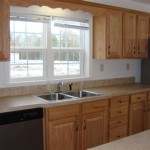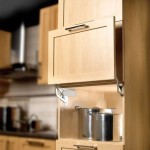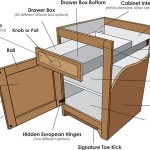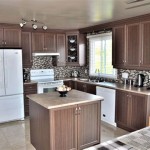Choosing the Right Paint to Repaint Kitchen Cabinets with White Appliances
Repainting kitchen cabinets is a cost-effective method of updating a kitchen's aesthetic without the expense of a full remodel. When white appliances are present, selecting the correct paint color and type becomes even more critical to achieve a cohesive and stylish look. This article explores the various aspects of choosing the optimal paint for repainting kitchen cabinets in kitchens featuring white appliances, ensuring a durable and visually appealing result.
Understanding Paint Finishes and Their Impact
The paint finish significantly influences the overall appearance and practicality of repainted kitchen cabinets. Different finishes offer varying degrees of sheen, durability, and ease of cleaning, all of which are crucial considerations for a heavily used area like a kitchen. Selecting the right finish can enhance the visual appeal of the cabinets and contribute to their longevity.
Matte Finish: Matte paint possesses the lowest sheen level, providing a flat, non-reflective surface. While matte finishes can effectively conceal imperfections on cabinet surfaces, they are generally less durable and more difficult to clean. This makes them less ideal for kitchen cabinets, which are prone to splashes and spills.
Eggshell Finish: Eggshell paint offers a slightly higher sheen level than matte, resembling the subtle luster of an eggshell. It provides a good balance between concealing imperfections and offering improved durability compared to a matte finish. Eggshell is a viable option for cabinets in lower-traffic areas or for homeowners who prioritize a softer, less glossy look.
Satin Finish: Satin paint is a popular choice for kitchen cabinets due to its smooth, velvety appearance and increased durability and cleanability. It offers a moderate sheen level that reflects light without being overly glossy, making it easier to wipe away grease and grime. Satin is a practical option for most kitchen environments.
Semi-Gloss Finish: Semi-gloss paint provides a higher sheen level than satin, making it even more durable and easier to clean. It is highly resistant to moisture and stains, making it well-suited for areas prone to frequent spills and splashes, such as around the sink and stove. However, semi-gloss can highlight imperfections on cabinet surfaces, so proper preparation is essential.
High-Gloss Finish: High-gloss paint offers the highest sheen level, providing a shiny, reflective surface. It is exceptionally durable and easy to clean, but it also accentuates any imperfections on the cabinet surface. While high-gloss can create a dramatic and modern look, it requires meticulous surface preparation to avoid highlighting flaws.
In the context of white appliances, a satin or semi-gloss finish is generally recommended for kitchen cabinets. These finishes provide a good balance of durability, cleanability, and visual appeal, complementing the clean aesthetic of white appliances without appearing too stark or unforgiving.
Exploring Paint Types: Latex vs. Oil-Based
The type of paint used on kitchen cabinets is another critical factor influencing the final outcome. Latex and oil-based paints possess distinct properties that affect their application, durability, and overall suitability for cabinet repainting.
Latex Paint: Latex paints are water-based, making them easier to clean up and less prone to yellowing over time compared to oil-based paints. They are also lower in volatile organic compounds (VOCs), making them a more environmentally friendly choice. Modern latex paints offer excellent adhesion and durability, making them a suitable option for kitchen cabinets.
Oil-Based Paint: Oil-based paints offer a hard, durable finish that is highly resistant to scratches and stains. They also provide excellent leveling, resulting in a smooth, even surface. However, oil-based paints require mineral spirits for cleanup, emit higher levels of VOCs, and are more prone to yellowing over time, particularly in lighter colors.
For kitchen cabinets, latex paint is generally preferred due to its ease of use, low VOC content, and excellent durability. However, if the existing cabinets are painted with oil-based paint, priming with an oil-based primer is essential to ensure proper adhesion of the latex topcoat. Using a high-quality acrylic latex paint specifically formulated for cabinets and trim will further enhance its durability and resistance to wear and tear.
Additionally, consider using paints with built-in stain-blocking properties. Kitchen cabinets are susceptible to grease and food stains, and using a stain-blocking paint can help prevent these stains from seeping through the paint and discoloring the finish.
Selecting the Ideal White Paint Color
Choosing the right white paint color for kitchen cabinets with white appliances is crucial for achieving a harmonious and balanced aesthetic. While white might seem like a simple choice, there is a wide range of white shades, each with its unique undertones that can either complement or clash with existing elements in the kitchen.
Understanding Undertones: White paints are not all created equal. They can have warm, cool, or neutral undertones. Warm whites have hints of yellow, orange, or red, while cool whites have hints of blue, green, or gray. Neutral whites have minimal undertones and are generally considered the most versatile.
Matching Appliance Tone: The first step in selecting a white paint color is to determine the undertone of the white appliances. Some white appliances have a slightly creamy or warm tone, while others have a cooler, brighter white. Matching the paint color's undertone to the appliance's undertone will create a more cohesive look. For example, if the appliances have a warm white tone, choosing a white paint with a slight yellow or cream undertone will create a harmonious blend.
Considering Natural Light: The amount of natural light in the kitchen can significantly impact how a white paint color appears. In a kitchen with abundant natural light, cooler whites can appear brighter and more refreshing. In a kitchen with limited natural light, warmer whites can help create a more inviting and cozy atmosphere.
Evaluating Existing Elements: The existing countertops, backsplash, and flooring should also be considered when selecting a white paint color. If the countertops are warm-toned granite, choosing a warm white paint for the cabinets will create a more cohesive look. If the backsplash is a cool-toned tile, choosing a cool white paint for the cabinets will create a more balanced aesthetic.
Testing Paint Samples: The best way to determine the ideal white paint color is to test samples in the kitchen. Paint small sections of the cabinet doors with different white paint colors and observe them under varying lighting conditions throughout the day. This will help determine which white color best complements the appliances, existing elements, and overall kitchen aesthetic.
Popular white paint colors that often work well with white appliances include: Simply White (Benjamin Moore), White Dove (Benjamin Moore), Chantilly Lace (Benjamin Moore), Decorator's White (Benjamin Moore), and Pure White (Sherwin-Williams). These colors are versatile and can be adapted to various kitchen styles and lighting conditions.
Preparing Kitchen Cabinets For Paint
Proper preparation is crucial for achieving a professional-looking and long-lasting paint finish on kitchen cabinets. Neglecting this step can lead to poor adhesion, uneven coverage, and premature chipping or peeling. A thorough preparation process ensures the paint adheres properly to the cabinet surface and creates a smooth, durable finish.
Removing Hardware and Doors: Begin by removing all hardware, such as knobs, pulls, hinges, and latches, from the cabinets. This will prevent paint from getting on the hardware and allow for easier painting. Next, remove the cabinet doors and drawers from the frames. This will allow for a more thorough and even paint application.
Cleaning the Cabinet Surfaces: Thoroughly clean all cabinet surfaces with a degreasing cleaner to remove any grease, grime, or dirt. Kitchen cabinets are often exposed to cooking splatters and food residue, which can interfere with paint adhesion. Rinse the cabinets with clean water and allow them to dry completely.
Sanding the Cabinet Surfaces: Sanding the cabinet surfaces creates a slightly roughened texture that allows the paint to adhere better. Use a medium-grit sandpaper (120-150 grit) to lightly sand the entire surface of each cabinet door and frame. Pay particular attention to any glossy or smooth areas. After sanding, wipe down the cabinets with a tack cloth to remove any sanding dust.
Priming the Cabinet Surfaces: Primer is essential for creating a uniform surface for the paint to adhere to. Primer also helps to seal the cabinet surface, prevent stains from bleeding through the paint, and improve the overall durability of the finish. Apply one or two coats of high-quality primer, allowing each coat to dry completely before applying the next. Use a primer that is specifically formulated for cabinets and trim.
Repairing Damage: Inspect the cabinets for any damage, such as dents, scratches, or chips. Fill any imperfections with wood filler and allow it to dry completely. Sand the wood filler smooth and prime the repaired areas before painting.
Applying Paint to Kitchen Cabinets
The application process is just as important as choosing the right paint and preparing the cabinets. Using the correct techniques and tools will ensure a smooth, even, and professional-looking finish.
Choosing the Right Tools: For best results, use a combination of a high-quality paintbrush and a small foam roller. A paintbrush is ideal for applying paint to corners, edges, and detailed areas, while a foam roller provides a smooth, even finish on larger surfaces. Avoid using inexpensive brushes or rollers, as they can leave behind brush strokes or lint in the paint.
Applying Thin Coats: Apply thin, even coats of paint, allowing each coat to dry completely before applying the next. Avoid applying thick coats of paint, as this can lead to drips, runs, and uneven drying. Two or three thin coats of paint are typically required to achieve full coverage and a durable finish.
Sanding Between Coats: Lightly sand the cabinets with fine-grit sandpaper (220-grit) between coats of paint to remove any imperfections and create a smoother surface for the next coat. Wipe down the cabinets with a tack cloth to remove any sanding dust before applying the next coat of paint.
Proper Drying Time: Allow the paint to dry completely between coats, following the manufacturer's instructions. Rushing the drying process can lead to a soft, tacky finish that is prone to damage.
Reassembling Cabinets: Once the paint is completely dry, reattach the hardware and reassemble the cabinets. Be careful not to scratch or damage the new paint finish during reassembly.

Kitchen Transformation White Cabinets Painted Counters With Appliances Project Goble

Kitchen Ideas Decorating With White Appliances Painted Cabinets Kylie M Interiors

Kitchen Transformation White Cabinets Painted Counters With Appliances Project Goble

Kitchen Ideas Decorating With White Appliances Painted Cabinets Grey Designs Outdoor

Kitchen Ideas Decorating With White Appliances Painted Cabinets Best Lighting Inspirations Colors

Bright White Kitchen Makeover On A Budget

Kitchen Ideas Decorating With White Appliances Painted Cabinets Kylie M Interiors

My Painted Cabinets Two Years Later The Good Bad Ugly

Kitchen Ideas Decorating With White Appliances Painted Cabinets Kylie M Interiors

How To Re Paint Your Yucky White Cabinets








